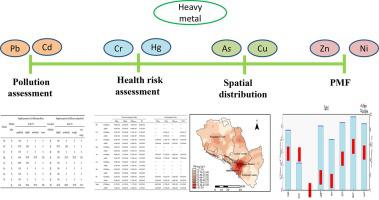Ecological Indicators ( IF 7.0 ) Pub Date : 2021-02-20 , DOI: 10.1016/j.ecolind.2021.107507 Lei Chai , Yuhong Wang , Xin Wang , Liang Ma , Zhenxiang Cheng , Limin Su

|
For the purpose of pollution assessment, human health risk assessment and quantitative source apportionment of heavy metals in cultivated soils, a total of 382 cultivated soil samples were collected from cultivated of Lanzhou in September 2019. Various indices, including pollution index (PI), Nemerow integrated pollution index (NIPI) and potential ecological risk index (RI) were used to analyze the pollution levels caused by heavy metals. Human health risk assessment, geographic information system (GIS) and positive matrix factorization (PMF) receptor modeling were employed to analyze the human health risk and source of heavy metals. The results showed that mean concentrations of Hg exceeded the national soil pollution risk screening value (GB 15618–2018). Spatially, except Cr in the study area, Pb, Cd, As, Cu, Zn and Ni have high value in Chengguan and Qilihe. Hg has high values in study areas outside Chengguan, Anning and Qilihe. The Nemerow integrated pollution index showed that the moderate and severe samples sites were 37.70% and 3.66%, respectively. The potential ecological risk indicates that most of the sampling sites are moderate risks. According to the health risk assessment results, the carcinogenic and non-carcinogenic risks of heavy metals to the human body are insignificant. Based on positive matrix factorization, there are four main sources of eight heavy metals. Pb, Cd, Zn and Ni were attributed to traffic sources; Hg were closely related to agricultural activities and medical treatment; Cr, Cu and Ni originated from natural source, As was derived from industrial activity. In this study enhance understanding of the pollution levers of heavy metals in Lanzhou cultivated soils, and also serves as reference for pollution source apportionment in other regions.
中文翻译:

兰州耕地土壤重金属的污染特征,空间分布和源解析
为了进行污染评估,人类健康风险评估和耕作土壤中重金属的定量源分配,2019年9月从兰州耕地收集了382个耕种土壤样品。各种指标,包括污染指数(PI),Nemerow综合污染指数(NIPI)和潜在生态风险指数(RI)用于分析重金属造成的污染水平。人体健康风险评估,地理信息系统(GIS)和正矩阵分解(PMF)受体建模用于分析人类健康风险和重金属来源。结果表明,汞的平均浓度超过了国家土壤污染风险筛查值(GB 15618–2018)。在空间上,除研究区的Cr以外,城关和七里河的Pb,Cd,As,Cu,Zn和Ni均具有较高的价值。汞在城关,安宁和七里河以外的研究区具有很高的价值。Nemerow综合污染指数显示,中度和重度样品站点分别为37.70%和3.66%。潜在的生态风险表明大多数采样点属于中等风险。根据健康风险评估结果,重金属对人体的致癌和非致癌风险微不足道。基于正矩阵分解,主要有八种重金属的四种来源。铅 镉,锌和镍归因于交通来源。汞与农业活动和医疗密切相关;Cr,Cu和Ni源自自然资源,As源自工业活动。本研究加深了对兰州耕地土壤重金属污染杠杆的理解,并为其他地区的污染源分配提供了参考。











































 京公网安备 11010802027423号
京公网安备 11010802027423号